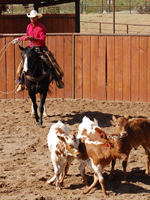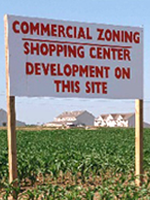
Yarbrough, John D.About | Story: I Wanna be a Cowboy | Abstract AboutPersonal and local history is followed by a discussion of the founding of the New Mexico Farm and Ranch Heritage Museum.
Story: I Wanna be a Cowboy
John Yarbrough: We had some friends by the name of Caldwell--Floyd Caldwell, and Floyd was a rancher, had some cattle up in the Organ Mountains on the Beasley Ranch, which is now Soledad Canyon. And the first time I remember going with Floyd up to the Organs, a semi-truck-load of cattle had turned over up there, and I'd had to be about eleven or twelve years old, but Floyd asked me to go with him. He just liked me, I guess, and I certainly liked him. So, we went up into Soledad Canyon, and I don't recall how they got the truck straightened up and the cattle gathered, but anyhow, then later on, Floyd owned part of the Ladder Ranch up here, called the Hermosa, which is about a ninety-section permit place. So, Floyd used to take me up there. I was thirteen or fourteen years old, so, that's why I started trying to learn to be a cowboy, just on my own. And then after that, I had opportunity to go to work full time for A. B. Cox. This was 1952, but in '51, I met Hal Cox, 'cause he brought his horses into Las Cruces at a place that the Corralitos Ranch had kind of some stables for some of their horses. And Hal brought his horses, mares, and had some stallions in there. Hal asked me to help ride his horses, and so, naturally, that was right up my alley because I had a horse or two there that I was keeping while I was in high school. And then through Hal I met A. B. Cox, and then asked him for a job, and, by golly, he hired me. And so then he helped straighten out all the wrongs that I had learned and kind of worked from there. Jane O'Cain: In no uncertain terms. (Laughs.) JY: That's right, that's right. Abstract
Tape 1, Side A
Yarbrough was interviewed for the "Founders" oral history project because he was an early foundation board member. The consultant was born at the Hotel Dieu in El Paso, Texas, on November 27, 1935. His father was stationed in El Paso while working for the Texas Department of Public Safety. Yarbrough's grandfather was the first marshal of Midland, Texas, and his father was a Texas Ranger in the 1920s and 1930s. He describes that his grandfather had a "personal vendetta" against Bonnie Parker and Clyde Barrow. Yarbrough's mother wrote a book about growing up in West Texas. She was born in 1912. Yarbrough's parents moved to Las Cruces in 1945, after having their crops destroyed by floods on two occasions on their farm along the Pecos River in Texas. He describes the lawlessness that existed along the United States/Mexico border as a result of bootlegging during Prohibition. His father, who worked the border area, was wounded on several occasions. He discusses one of his father's law enforcement partners, Fred Griffin, a "real character." Yarbrough began working for local ranchers Floyd Caldwell and A. B. Cox when he was an adolescent. He was surprised when he started school in Las Cruces because in Texas the schools were segregated. He had never attended schools with Hispanic children. African American students in Las Cruces attended the Booker T. Washington school. He learned a great deal of local history through his association with the Cox family. Mother Cox, wife of W. W. Cox, and her daughters Lena, Blanche, and Lou would spend time with him reminiscing. Yarbrough relates what happened to the Cox Ranch when the military took a large percentage of the land for the White Sands Proving Ground. A. B. Cox bought Henry Opgenorth's ranch near Hillsboro and allowed Yarbrough to run cattle on his place for several years. A. B. Cox transferred the bridle bit brand to Yarbrough. The bridle bit was a very old brand previously owned by the Opgenorths. The consultant majored in animal husbandry at the New Mexico State University and discusses two well-known professors from the 1950s, Professor Know and Professor Neale. The Agricultural College was very prominent at that time; it is less so today.
Tape 1, Side B
During college Yarbrough was enrolled in R. O. T. C, which was mandatory. After college he served two years in the Army in military intelligence. Immediately after the service he was asked to join with his aunt in the oil jobber business in Las Cruces. Eventually the company diversified into operating truck stops, self-storage companies, and convenience stores. His aunt retired in the mid-1980s, and the work became very stressful. He discusses his aunt's attributes as a businesswoman in a non-traditional field. The consultant discusses again some of the anecdotes that he was told by Lena Cox, oldest child of W. W. Cox. The interview focuses on the establishment of the New Mexico Farm and Ranch Heritage Museum (hereafter Museum). He was approached by Art Evans of Hillsboro and asked to serve on the foundation board. He believes he was approached about eight years previous to the interview about serving on the board. Yarbrough discusses the difficulty in raising private monies for the Museum and stated he was "very, very disappointed in the lack of . . . personal financial support." He doesn't believe that the lack of support was totally predicated on the agricultural economy because when they first started to raise funds the "cow market's pretty good," unlike how it has been for the past three years. Yarbrough, from his own business experience, states that proper signage and marketing of the Museum is critical. He is optimistic about the number of visitors the Museum will attract given its location at the junction of two interstate highways. He believe the prime location site for the Museum was the site located in the vicinity of Memorial Medical Center in Las Cruces; however, he stated there would be some difficulty in having animal exhibits there.
Tape 2, Side A
Yarbrough did not support the removal of the Museum from the Office of Cultural Affairs to the State Department of Agriculture or to New Mexico State University as proposed in January of 1995. He states that Dr. Bill Stephens and Rob Cox were influential in the development of the Museum and has thought that Dr. Stephens' contribution could be memorialized through the commission of a sculpture. The consultant is interested in promoting the state through the Museum and believes that it could be an important component in arranging conventions and tours in Las Cruces. He thinks that Europeans, with their interest in the West, might be convinced to tour the Museum. He discusses the need to present an accurate and authentic portrait of rural life and rural people. |

